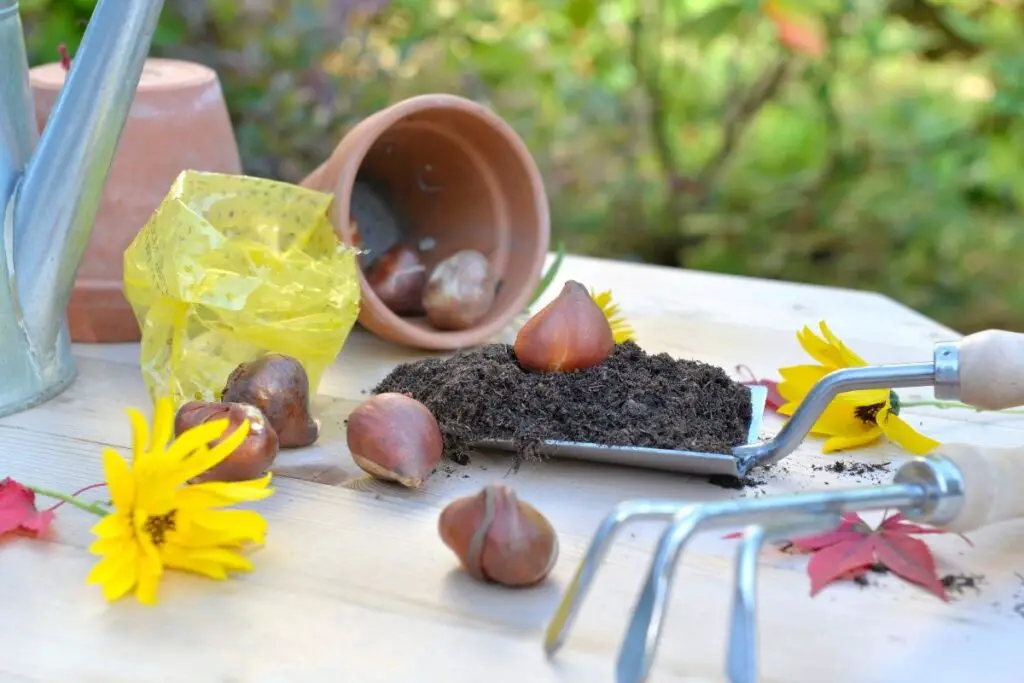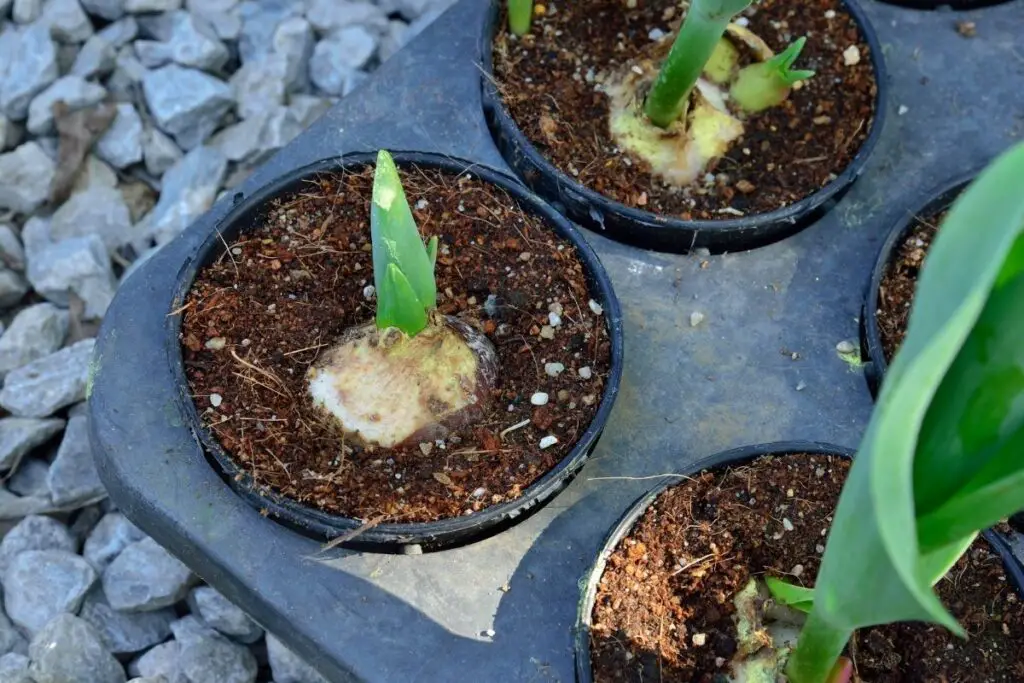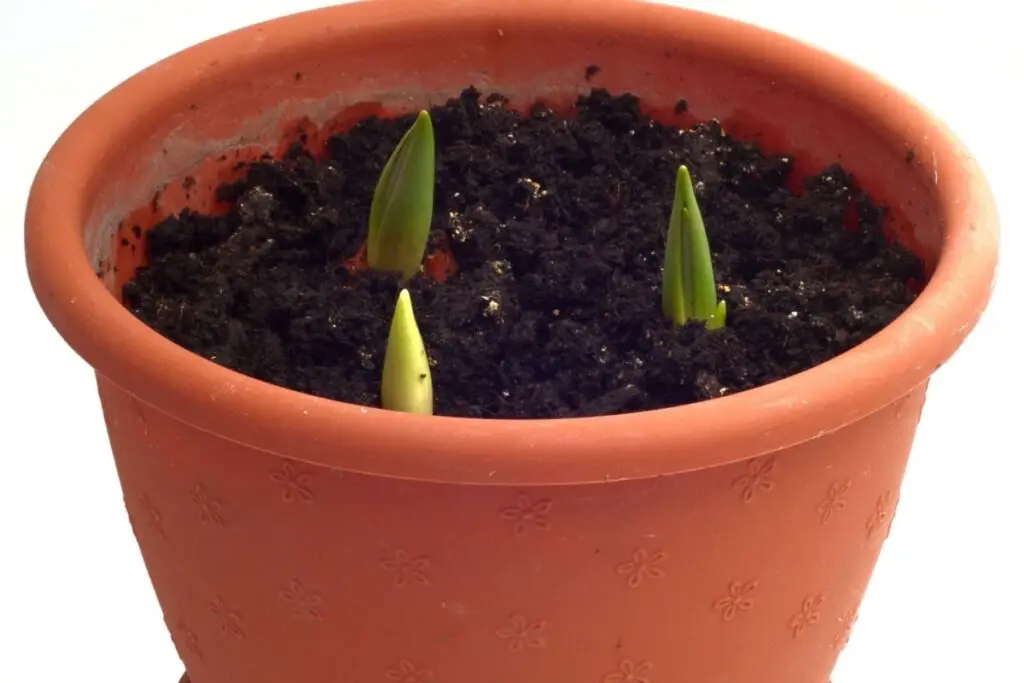Bulb flowers like tulips are a joy to plant in your backyard gardens. Pre-planning before proceeding to plant the bulbs can ensure the most abundant blooming displays. Every gardener gets curious about how long their tulip bulbs will take to sprout and grow.
So, in this article we shall understand when do tulips start sprouting and how long will it take to sprout.
As a general rule, tulips need 10-16 weeks of chilling so that they are prepared to be planted. Once the soil temperature outside is below 55°F, you can sow the seed and expect it to sprout in the next 1-3 weeks. Once the plant has sprouted, it will take 2-3 weeks to grow and flower.
In this article, we have covered the information you need regarding the sprouting of tulip bulbs, so keep reading to find out more.

The best time to plant tulip bulbs
Tulips remain dormant during the hot summers as they fail to set their roots in stressful and heavily moist environments.
Waiting till October-November, when the air is cool and pleasant, is an intelligent choice to plant your tulip bulbs. You can easily avert the occurrence of fungal problems now that the soil isn’t radiating heat.
By this time, the local rodents also won’t be very eager to attack your bulbs.
The fall weather helps the bulbs re-establish their roots and absorb enough moisture and energy to sustain the cold. Planting the bulbs in fall also increases their elasticity, which plays a vital role in the bursting of bulbs into bloom with the return of spring.
If the ground doesn’t freeze, you can plant the spring-flowering bulbs as late as early December. Night-time temperatures should be around 40-50°F when you are planting the bulbs.
The leftover bulbs that have lasted through winter can be planted in early spring to prevent a waste of resources.
Any bulb that has turned soft and mushy or excessively dry and crumbly should be discarded immediately and shouldn’t be planted.
The major downside is that such bulbs are more likely to not bloom at all or bloom late due to their fragile roots.
Also read: When’s The Best Time To Plant Tulips? (+After Plant Care)
How to plant tulip bulbs outdoors?
As per the North Carolina State University Cooperative Extension, you should plant tulips in rich and well-draining soil.
To speed up the process of planting a group of around 50 bulbs simultaneously, you can dig the entire garden bed to a depth of about 4-6 inches.
Remember to space out the bulbs to at least 2-5 inches depending on the size of the plant to keep fungal diseases away.
In addition to this, you should always position the tulips with their pointy end facing upwards. Full sun is needed for the optimal growth of the tulip bulbs.
Lastly, the bulbs will require thorough watering in the first week after they are planted when it comes to watering. You can add a layer of compost, bone meal, or peat to increase the nutrient content of the soil effectively.
Also read: When To Plant Tulips Seeds? (Guide As Per Your Zone)
The growing stages of tulips

First stage: This refers to when tulip bulbs are planted from September to November. The moist soil present in the soil then stimulates the growth of the bulb underground. In the initial growth cycle, the tear-drop-shaped bulb looks like a solid mass.
Soon after being planted, roots start growing from the bulb to anchor the bulb into the soil and harness nourishment. It will form a strong root system after 2 months of planting the bulbs. This prepares the mother bulbs for the winter.
Second stage: Over winter, the tulips enter a state of rest. The bulbs continue to extend their roots into the soil. Also, the soil protects the bulbs from freezing due to the cold.
The cold climate triggers change within the bulb to start preparing for growth.
Third stage: In the growing period, as the starch in the bulbs turns to sugar, the bulbs change in appearance.
As the air gets warmer, there is a burst of growth in the tulip bulbs. At the end of winter, you will notice a healthy green shoot sprouting out from the bulb. Through the utilization of both stored and new energy, a bud is also produced.
Fourth stage: The tulips begin to bloom in spring after they receive enough water and nutrients.
After the blooming, in May-June, the energy in the leaves moves towards growing new small bulbs. Now, the tulip bloom fades. But the leaves remain on the tulip long after that.
This makes it essential to leave the foliage on your tulips until they turn yellow, as they are responsible for regulating photosynthesis.
If you trim the leaves too early, the new bulbs will be deprived of energy. After the end of the yearly cycle, the bulbs stay dormant wilfully.
Also read: Should Tulips Be Planted In Groups? (How To+Care)
Looking for gardening supplies? We have tested 100's of products before recommending them to you guys. Check out our best pick below:
| Image | Gardening Supplies | Best Price? |
|---|---|---|
 Top
Top Top
Top | Raised Garden Bed Kit | Check On Amazon |
 | XLUX Soil Moisture Meter, Plant Water Monitor, Soil Hygrometer Sensor for Gardening, Farming, Indoor and Outdoor Plants, No Batteries Required | No Results |
 Top
Top Top
Top | 82 Pcs Garden Tools Set and Extra Succulent Tools Set | Check On Amazon |
 | Joeys Garden Expandable Garden Hose with 8 Function Hose Nozzle, Lightweight Anti-Kink Flexible Garden Hoses, Extra Strength Fabric with Double Latex Core, (50 FT, Black) | No Results |
 Top
Top Top
Top | Dual Chamber Compost Tumbler | Check On Amazon |
 Top
Top Top
Top | Sunnyglade Plant Stakes | Check On Amazon |
 Top
Top Top
Top | Organic Cold Pressed Neem Seed Oil | Check On Amazon |
 Top
Top Top
Top | Mighty Mint Gallon :-Insect and Pest Control Peppermint Oil | Check On Amazon |
 Top
Top Top
Top | Scotts DiseaseEx Lawn Fungicide | Check On Amazon |
 Top
Top Top
Top | Jacks Classic 20-20-20 All Purpose Fertilizer | Check On Amazon |
 Top
Top Top
Top | 30,000 Seeds Pollinator Attracting Wildflower Mixture | Check On Amazon |
 Top
Top Top
Top | Survival Vegetable Seeds Garden Kit-Over 16,000 Seeds | Check On Amazon |
How long do tulips take to sprout?

Most tulip bulbs require a minimum of 10-16 weeks of chilling to bloom into beautiful flowers. This means that they have to experience cold temperatures of 35-45°F consistently.
The specific time needed by the bulbs for sprouting and blooming varies from species to species. Usually, the tulip bulbs are expected to sprout within one to three weeks of the cold period.
Tulips start their chilling period from the middle of September. Before that, they are not ready for winter sleep.
All tulips must start their cold period before December. There will be no use for bulbs bought after December unless they have been pre-chilled.
Due to the pre-requisite of low temperatures, it becomes difficult to grow tulips in tropical climates. But even in warm weather, you can make the tulip bulbs think they have gone through a cold winter by pre-chilling.
You need to place the bulbs in a paper bag or egg carton inside the kitchen refrigerator. Punch holes in the bags to create a well-ventilated atmosphere.
Do not store the bulbs close to vegetables or fruits like apples, as their ripening effect emits ethylene gas. And this ethylene will cause the bulbs to rot, ultimately killing the flower inside.
Chill the bulbs for 10 to 16 weeks, depending on the soil temperature. But they can stay in the cold storage for several months more without any harmful effects.
Do not let your tulip bulbs warm up in the sun. Take the bulbs directly to your planting location from the refrigerator to prevent any loss of the vernalization.
You should plan the chilling time in a way that the bulbs end up being planted in the ground in the fall months.
The bulb starts to sprout after it roots into the soil well, taking close to a month. Then, they are sure to bloom in Spring, from March to May.
Why do tulip bulbs sprout early?
Gardeners are often concerned with tulip bulbs coming up in the mid-winters. Thankfully, this premature sprouting does not pose as great a danger as one might assume.
In addition to tulips, other spring-flower bulbs like daffodils start to develop their root systems and can sprout very soon after being planted. Do not be stressed if the spring bulbs start to produce flowers.
Especially when the winter weather turns erratic and hot, the tulip bulbs tend to rise to the soil surface.
Thus, this sprouting can mostly be discovered on the south/west side of the yard, which is warmer than other parts due to sunlight reflecting off the building.
Ways to prevent tulip bulbs from coming up early
Though, it is surprisingly remarkable of the hardy spring bulbs to adapt to changing temperatures with resilience.
Let’s look at a few steps that you can take to slow down this rapid sprouting and provide protection to the flowering shoot.
1. Cover your plant
As long as the bulbs are underground, they remain sheltered from the extreme cold. But as soon as they come up, they are exposed to the drying winds.
That is why it’s essential to protect your tulip plant by covering the soil around the bulb with a layer of mulch, pine needles, bark chips, or leaves.
2. Water sufficiently
Ensure to water a little extra whenever there is an extended dry spell to help the bulbs grow better. Since the tulip bulbs are prone to root rot, the soil must have good drainage.
3. Maintain the correct depth
Ensure that the bulbs are planted at a depth of three times their height.
If you end up planting them too shallow, they might fall prey to premature sprouting and get destroyed by frost heaves. Also, planting the tulip bulbs upside down can hamper their growth.
What happens if unplanted tulip bulbs sprout?

A tulip bulb that ends up sprouting in storage before it’s chilled would not produce any flowers before a season or even two. However, if you desire to save them, plant the sprouted bulbs as soon as the conditions are right.
It is important to carefully inspect the bulbs that have begun to sprout for any signs of withering or damage before rushing to plant them.
Extended storage periods can significantly diminish a bulb’s energy and can easily succumb to soil-borne diseases.
To determine their weight, hold the sprouted bulbs in your hand. If they are too light or heavy concerning their size, it’s best not to keep them.
With the advent of spring, get to planting your bulbs in the chosen location outdoors. You should plant them just like any regular bulb is planted. Just make sure that the sprout is not broken.
Why do some tulip bulbs don’t sprout?
There can be several reasons behind tulip bulbs not sprouting. Here are some of them:
- If the bulbs are immature and yet to develop fully, they would not sprout in the first year itself.
- The bulbs may not sprout due to an influx of pests and wrong timing in planting the bulbs.
- Crowding of too many bulbs in one location can lead to intense fighting for light, water, and nutrients. This kind of competition can be detrimental to sprouting. Try to divide the bulbs as soon as the current flowering cycle is completed.
- Poor drainage in the soil or overwatering can also cause the bulbs to not sprout on time. Do not use heavy clay soil, and plant your tulips carefully on a raised garden bed.
- All tulip bulbs require adequate direct sunlight. When they do not receive that, their bulbs don’t sprout. There also exist bulbs better suited to scattered shade. Thus, it is vital to research the bulbs you choose and create conditions accordingly.
- Too much fertilizer can negatively interfere with the bulb’s sprouting or kill it. You should fertilize bulbs only once in the fall with a unique bulb fertilizer.
- Sudden temperature fluctuations can also lead to the eventual folding of bulbs that had a good start initially.
Final words
Now you know that tulip bulbs take a few weeks after the chilling period to sprout. Many in the gardening community are unaware of how tulips can also be a tricky plant to deal with at times.
When the tulip bulbs in our gardens don’t receive the perfect conditions, they are more likely not to rebloom.
A gardener can easily ensure that the tulips come back every year by planting them in intense sun, away from house foundations to the correct depth.
Instead of going for the exciting newer hybrids, you should plant the forgiving old-fashioned tulip varieties in mounds to get a blooming year after year. Allow your tulip foliage to die back naturally to get your tulips to rebloom annually.
Source: Wikipedia, North Dakota Stae University, The Royal Horticultural Society.
